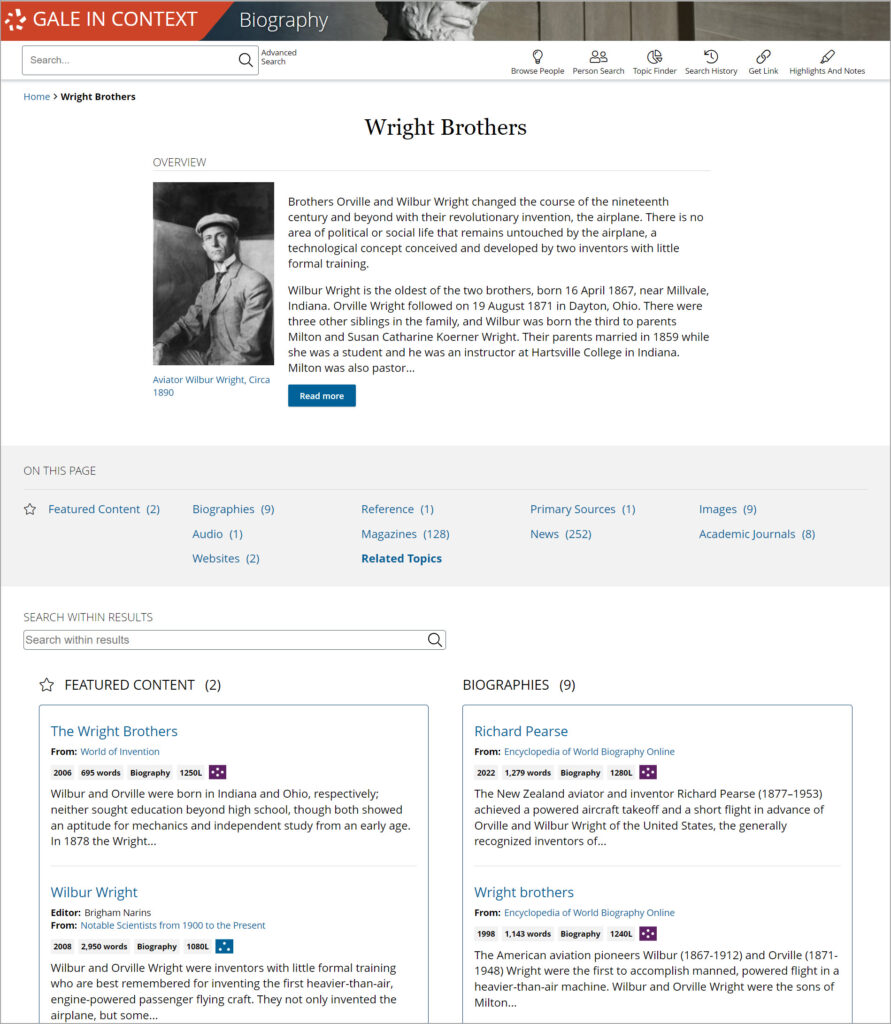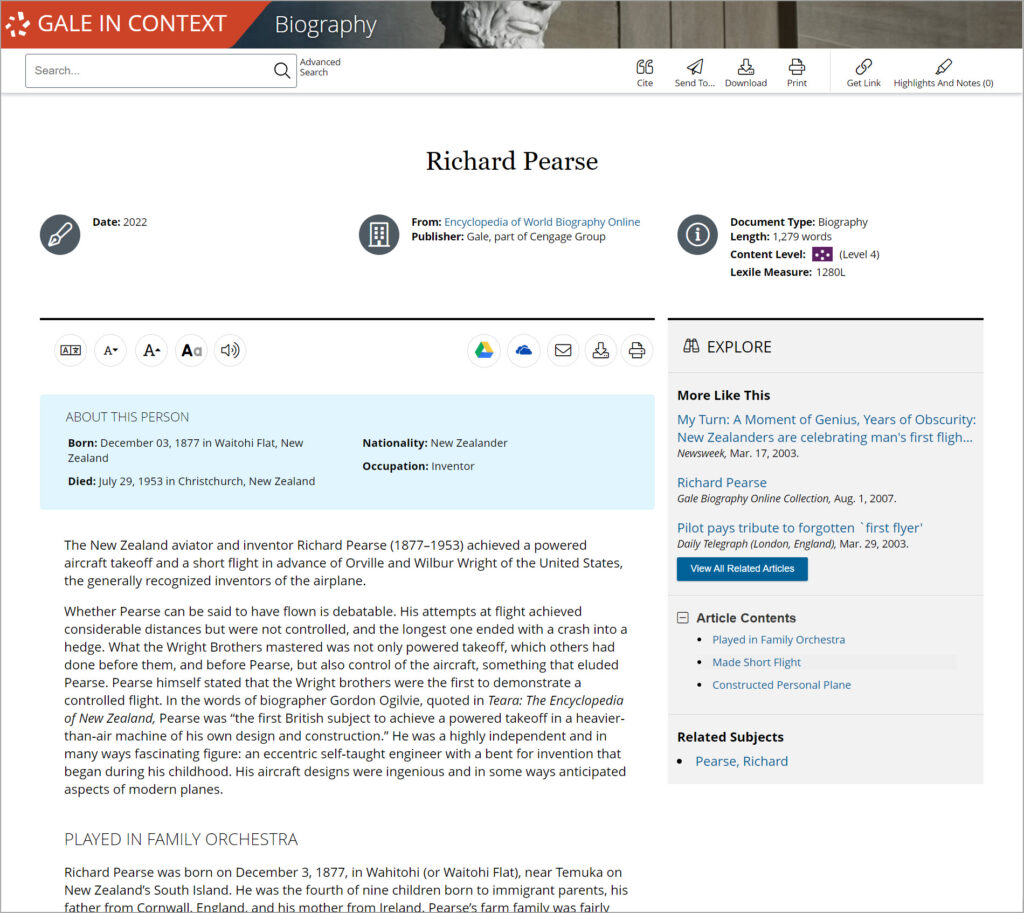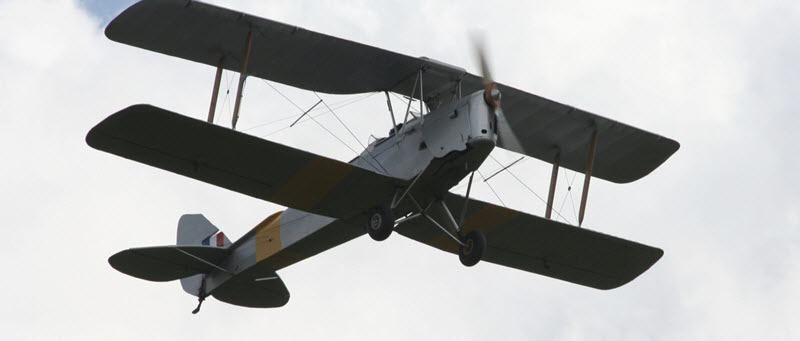| By Gale Staff |
The world changed forever on December 17, 1903 when two brothers, Wilbur and Orville Wright, successfully piloted the first airplane. It’s an iconic story of innovation and perseverance reflecting American values of the early 20th century. Decades later, in 1959, President Dwight D. Eisenhower proclaimed December 17 as Wright Brothers Day in honor of the inaugural flight’s anniversary.
The Wright brothers’ story is captivating and historically significant for young readers for a number of reasons, including its showcasing of the process of discovery involved in aviation. This December, explore Gale In Context: Biography and inspire others with the history of these two exemplary American figures. As an inherently interdisciplinary topic, the story of the Wright Brothers helps you create exciting connections for learners in history, reading, and science.
Gale In Context: Biography is an online database designed for K-12 learners. Users of all ages, even elementary school students, can easily navigate the extensive collection of biographical entries housed in our research portal. Young learners can use convenient search features, including the ability to filter information based on an individual’s name, occupation, ethnicity, gender, and more. Plus, Gale’s content is comprehensive and vetted by experts to give you additional peace of mind. So, you never have to worry about your students stumbling onto misinformation or biased content like they might do through a traditional search engine.
This winter, take advantage of Gale In Context: Biography’s Wright Brothers collection, including primary sources, videos, podcasts, images, and newspaper articles. It’s a wealth of historical information guaranteed to ignite your students’ curiosity. Additionally, Gale’s dedicated portal can help students develop early research skills.

Teach the Basic Science of Aviation
Gale in Context: Biography has valuable resources to support engaging, curriculum-aligned lesson plans for all subjects. But Wright Brothers Day content lends itself particularly well to science classes with its focus on the fundamentals of flight and how the Wright brothers managed to successfully defeat gravity.
The Wright brothers’ success first began with bicycles. They were fascinated with the modernity of two-wheeled transportation and it wasn’t long before their curiosity pivoted to the skies. Aeronautics was a new field and Wilbur and Orville Wright had a knack for transportation innovation and problem-solving. One of their first breakthroughs was recognizing how the angle of a plane’s wings helped produce lift and provide control over the aircraft. They applied their theories to a series of gliders, testing more than 200 different wing shapes and seeking a durable yet aerodynamic solution. Their scientific curiosity and persistence helped change the world.
Elementary Activity Idea: Make paper airplanes! Designing a paper airplane is a helpful, hands-on way to understand the fundamentals of aerodynamics. To fly, paper airplanes rely on the forces of lift and thrust; their shape must limit drag, and the material needs to be light enough to resist gravity. Consider having students compete to see whose plane travels furthest.
Discuss Different Historical Perspectives
The accomplishments of Wilbur and Orville Wright are largely undisputed, but some historians argue that the storied brothers were not the first to conquer the power of flight. Brazilian scholars, in particular, debate the claim. According to South American historians, the famous Kitty Hawk flight on December 17, 1903, did not follow the true definition of flight, nor did it meet scientific standards of proof. The “first flight” honor should instead go to Alberto Santos-Dumont, who, at a 1906 competition in France, managed to take off, fly, and land without external assistance.
History shows that the Wright Brothers were not alone in their quest for aviation and that other historical figures can claim credit for advancements in the field (many of whom influenced the Wright brothers’ work). Besides Santos-Dumont, New Zealand aviator Richard Pearse might also have a claim to make. Months before the Wright Brothers’ December 17th flight, Pearse built a small, engine-powered aircraft and demonstrated a successful flight for bystanders in his hometown of Wahitohi.

Discussion Idea: The different nuances and technicalities around the Wright Brothers’ claim to fame help demonstrate an important lesson — historical accounts are not always reliable. Human memory is fallible and certain stories can change based on who is telling it and the context in which it is told. Help guide your students through a discussion about shifting historical narratives, common myths, the dominance of Western perspectives, and ways to approach their own research with these considerations in mind.
Explore the Power of Biography
Biography is an especially powerful learning tool. Reading about others’ experiences allows students to make connections between those histories and their own lives, perhaps even discovering valuable role models.
With Gale In Context: Biography, you can learn about the lives of Orville and Wilbur Wright and their feats in aviation. Born in the Midwest, the two brothers had an innate talent for invention, entrepreneurship, and engineering although neither graduated from high school. While not the best students in the traditional classroom, they were optimistic and curious learners. Your young scholars might be interested to know that the initial spark for the Wright brothers’ pursuit of flight came from a simple toy helicopter they received as children.
Biographies can inspire us and teach lifelong lessons. Like the rest of us, the Wright brothers were human and faced their own challenges. They struggled with academics and failed dozens of times before getting it right. The story behind Wright Brothers Day is one of perseverance and optimism, values that all students can hold, no matter their academic prowess.
Activity Idea: Have students use Gale In Context: Biography to learn about other significant American inventors. Encourage each student to choose one such innovator and create a brief report on that person’s background and accomplishments. Have them pay particular attention to any qualities they share with those influential individuals. Examples include Alexander Graham Bell, Henry Ford, Stephanie Kwolek, George Washington Carver, and Steve Wozniak.

While Wright Brothers Day offers endless applications for learning in elementary classes, we know it can be challenging and time-consuming to create new lesson plans and find ways to integrate classroom resources on your own. That’s why our team at Gale has launched a unique planning and training database specifically for teachers. Gale In Context: For Educators features ready-made resources, including lesson plans and activities, aligned with your district’s curricular standards. Teachers can more easily collaborate with colleagues and customize information to meet individual student needs.
With Gale in Context: Biography, the sky’s the limit! You and your students have thousands of stories to explore and learn from, and each biographical entry features a list of related articles for deeper research.
If your institution isn’t a Gale in Context: Biography subscriber, learn more here and request a trial today.

